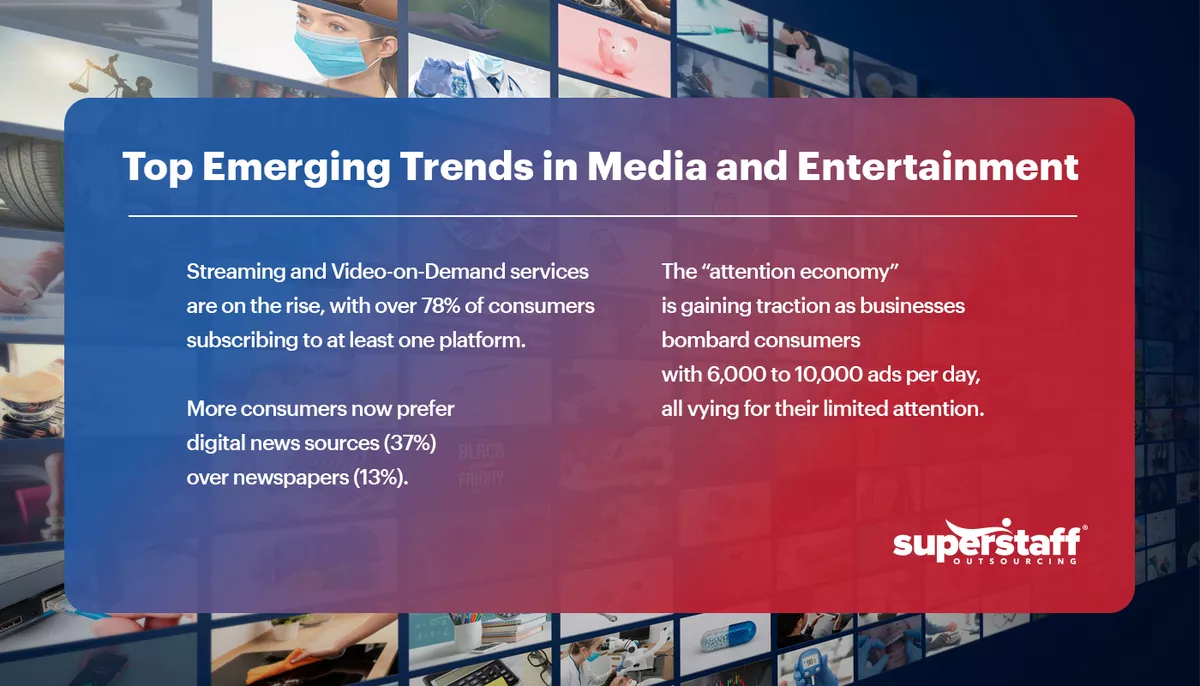
The influx of digital tech has reshaped the media and communications landscape as we know it. Apart from fueling the demand for convenience, it helped create an innovative, personalized, and immersive entertainment experience – paving the way for consumers to embrace emerging trends in the industry.
Take a look at these compelling numbers presented by the Motion Picture Association (MPA) THEME report covering 2020:
- The global home/mobile entertainment market hit $68.8 billion in 2020.
- Online subscriptions surpassed one billion for the first time.
With the vast potential and promise of lucrative returns in the industry, stakeholders need to maintain their momentum and gear up for the ever-evolving digital environment. A critical step towards that is outsourcing nearshore and offshore back office solutions for media and communications.
We must first understand the market today to stay ahead of the game. So, here are the top 3 media and communications trends that companies should prepare for in 2023:
Top 3 Media and Entertainment Trends of 2023 (and How Outsourcing Can Help Address These Challenges)

Rise of Streaming and Video-on-Demand (VOD) Services
People canceled social plans and confined themselves to their homes at the height of the pandemic. Many resorted to online streaming services like Netflix, Hulu, HBO, and Disney+ as entertainment to fill the void.
This fuelled seismic shifts in the media consumption experience. Instead of watching TV, most viewers are now more interested in binge-streaming online content and videos. Just take a look at these staggering numbers:
- Over three-fourths (78%) of consumers subscribe to at least one streaming platform, a spike from 52% in 2015.
- U.S. households use digital media for 13 hours and 11 minutes daily.
- By 2027, the market volume of VOD is expected to reach $230.9 billion.
The growing popularity of stay-at-home streaming also catapulted growth in the gaming industry, with live streaming platforms like YouTube and Twitch gaining traction as safe spaces for gamers to share their passion and connect with like-minded individuals.
Amid the massive potential of streaming and VOD, the industry shows no signs of pulling back. As the community grows, the market exhibits a robust compound annual growth rate (CAGR) of 10.44% from 2023-2027.
Consequently, many businesses are incorporating online content and live streaming into their marketing strategy to boost viewership and expand customer engagement. They collaborate with other content creators to create live or video-on-demand shoppable videos promoting their brand.
How Outsourcing Can Help
Because of the streaming wars, media and communication companies are racing to see who can make the highest number of quality content and clinch the most viewers.
Streaming platforms and corporate communication brands who want to build a global audience need content that resonates with their target market – and the first step in doing so is to shatter the linguistic divide with closed captioning and subtitles.
Communicating in their audience’s native language enables them to tap into the international market and gain a much larger viewership. Fortunately, these companies can delegate these tasks to the capable hands of an outsourced back office team from Colombia and the Philippines, enabling them to scale up their operations without overwhelming their core teams.
Demand for Instant News and Online Communication
As we move toward a more digital, mobile, and tech-centered environment, immediacy is no longer just an option but an imperative. Consumers expect fast and readily accessible content at their fingertips. So, a quick time-to-market is critical for both news and online communication.
News Access
A recent study revealed that most Americans obtain local news online, such as Facebook, Twitter, and TikTok. The study also showed that more are embracing digital news sources (37%) over newspapers (13%). Over half (51%) of online newsreaders do so mainly through mobile gadgets. Meanwhile, another survey echoed this, highlighting that most smartphone users access their devices first for news before television, radio, and newspapers.
Simply put, people want to read their news on the most digitally convenient platform possible.
However, due to personal biases and interests, the online sphere does pose a threat to the news industry. Notably, word choices affect one’s inclination to consume news content. For instance, research shows people are likelier to click on headlines with negatively associated words than positive ones.
Online Communication
Thanks to tech advancements, digital interactions can now be done in just a few clicks. Because of this, expectations for real-time updates have become socially ingrained among consumers.
This adds pressure to M&E companies. If you fail to cater to their speed needs, you’ll potentially lose them to your competitors. Let’s take a look at how vital speed is to customers:
- 64% value speed and responsiveness as much as they value the cost of goods.
- 40% who have to call you twice will be less likely to purchase from your brand.
How Outsourcing Can Help
Immediate action and instant gratification are what best describe consumers’ needs today.
However, due to the volume of customer touchpoints, burdening your in-house employees with administrative tasks – such as accounting, data entry, and IT – may hinder your ability to deliver fast, quality services. As such, it might be best for you to delegate these duties to an offshore or nearshore back office support team.
Outsourced workers are not just experts in their field. They also provide 24/7 professional back office support solutions for you and your clients. This frees up more time for your in-house employees to create real-time, quality coverage, allowing them to keep up with the growing demand for instant news and communication.
Emergence of the “Attention Economy”
When we think of scarce commodities, gold, diamonds, and oil typically come to mind. However, in this digital age where information is infinite, our “attention” becomes a finite resource that businesses must fiercely compete over — hence, the term “attention economy.”
With the U.S. population spending an average of 485 minutes engaging in digital media daily, businesses are taking advantage of this massive opportunity with online advertisements.
Since consumers are bombarded with 6,000 to 10,000 ads daily, content producers and marketers must devise effective and on-trend storytelling strategies to stand out and grab their target market’s attention – or they risk losing business to their competitors.
How Outsourcing Can Help
The ultimate goal of advertising is to earn the highest return on investment. However, due to its fast-paced and stressful nature, marketing teams will likely suffer extreme burnout.
And when employee morale declines, your bottom line also takes a hit.
Working with an experienced BPO partner allows media and communications companies to save on operational costs and channel more funds to their core operations. It also alleviates the burden of in-house marketing teams, boosting their work productivity and enhancing their well-being.
Back Office Service Solutions That Can Help Media and Entertainment Companies Keep Pace With Emerging Industry Trends

Back office support is the cornerstone of efficient, productive, and seamless business operations – without which repetitive and mundane tasks will bog down companies.
What back office solutions can media and communications companies outsource to enhance business success? Here are 7 of them:
Customer Service and Call Center Solutions
It’s no secret that lousy user experiences can spark customer churn. With endless commitment-free streaming sites available, your entertainment firm must deliver the best possible customer experience to nurture long-term relationships, boost customer happiness, and generate positive word-of-mouth referrals.
Some of the call center services media and communications companies can utilize include:
- Phone Support: For quick resolution, customers can report their urgent and complex subscription issues over the phone or SMS.
- Social Media Support: Companies can expand their outreach methods and address customer complaints through social media platforms like Facebook, Twitter, Instagram, and TikTok, among others.
- Email Support: An asynchronous communication channel that allows customers to convey ad hoc questions and concerns at their convenience. Companies can also thoroughly evaluate the inquiries before responding to them.
- In-App Support: Customers can send screenshots and submit tickets to their concerns within the app.
- Live Chat: Clients who don’t want to talk on the phone can communicate with a support agent through an instant messaging tool (or a proactive chat pop-up).
- Multilingual Support: If clients aren’t comfortable speaking in English, they will be transferred to an agent who can deliver the support in their mother tongue (such as Spanish, Portuguese, or Mandarin).
- Telemarketing and Telesales: Telemarketers first create product awareness for all clients and canvass promising leads. The telesales team will then convert those leads into sales.
However, good customer service doesn’t only entail good communication and listening skills. Customer service representatives must also be good at keeping tabs on past interactions – a strategy that call centers from Colombia and the Philippines have long mastered.
Gathering and compiling this data helps agents better understand customers’ characteristics, preferences, and behaviors. In future exchanges with customers, agents can:
- Accelerate ticket resolution by 73%
- Reduce waiting time for support by 65%
Information Technology (IT)
Cutting-edge technology is behind the success of the M&E industry, driving innovations such as realistic special effects in movies, interactive news media, and high-powered live gaming.
Simultaneously, digital tech has also introduced new forms of content creation and expanded its customer base beyond local borders.
However, as content streaming demands spike, the doors also open to uninvited data and privacy breaches:
- 73% of clients feel that using their personal data is “out of control.”
- 87% won’t conduct business with a firm if they are concerned about its security measures.
To protect their data integrity, M&E companies must work with qualified and dedicated outsourced IT providers able to maintain their daily operations effectively. This lays the foundation for the development of websites and mobile applications.
Here are some of the roles of IT solutions for media and communication enterprises:
- Technical Support and Helpdesk: Being the first point of contact, a helpdesk support rep answers customers’ general issues (such as upgrading app security or retrieving lost accounts). The concerns will be escalated to the technical support team when problems require specialized knowledge or expertise.
- Software Development: A team of IT specialists is dedicated to designing streaming and VOD-related software, offering operational necessities, and supporting its core functions. They also create ad-blocking software to prevent companies from tracking their online activities.
- Website Development: Applying technologies like HTML, PHP, and JavaScript, a web developer creates, builds, and maintains online media and communications websites and web applications on a browser.
- App Development: A process of creating an installable application that’s compatible with a mobile device.
Data Entry
Recognizing the immense potential of the platform, increasingly more U.S.-based companies are embracing social media marketing. As early as 2021, 91.9% of marketers in firms with over 100 employees were already projected to join the trend.
What does this mean for the M&E sector?
To stay ahead of the curve, businesses must promote their curated content across all social media channels for maximum engagement. This also means leveraging social media analytics tools to monitor their marketing performance and engagement in the online sphere.
Here are some of the uses of social media analytics:
- Spot mainstream trends
- Assess brand sentiments
- Set goals and objectives
While social media analytics is a critical step that lays the groundwork for practical analysis and strategic decision-making, it can be a resource-intensive task, especially when massive amounts of data are involved. Fortunately, data entry outsourcing can help.
Outsourcing firms bring specialized expertise and industry experience to the table. With cutting-edge data entry software, they safeguard the accuracy and quality of your data while streamlining the entire process for maximum speed and efficiency.
Research and Data Analytics
With the sheer volume of data communication teams have access to – media tonality, size, journalist tracking, and media mapping, to name a few – it’s high time for businesses to leverage these for a competitive advantage. Many are already doing so, with 94% of companies finding data and analytics critical to their digitization efforts.
Let’s take marketing, for instance, one of the most common uses of data insights. By taking a scientific approach to your strategy, you can obtain a 360-degree view of your audience’s media and content preferences.
Media and communication companies can extract deeper insights from customer behavior through research and data analysis. You will discover which content people engage with the most and preview other content genres and themes with the potential for high engagement.
However, while there’s no denying the impact of data on M&E, dynamic customer preferences have significantly tightened the margin of error regarding analytics. A simple data miscalculation could easily trigger a domino effect of costly mistakes harming your bottom line. Firms need to invest more in their research and data analytics initiatives to avoid these.
One effective strategy they can leverage is data science outsourcing. BPOs can provide you with the resources that will enable them to harness emerging opportunities, fine-tune their strategies, and amplify their messaging in an increasingly competitive landscape.
Finance and Accounting
The media and entertainment industry suffered a 50% dip in market shares in 2022 – the worst decline in 30 years. A year later, Vice Media (a digital titan once worth billions) filed bankruptcy, recording an outstanding debt of $834 million. Unfortunately, as content piracy drives subscriptions down, more U.S. entertainment businesses are forced into bankruptcy. Even streaming giants such as Netflix, Hulu, and Disney+ are not immune to this bleak reality.
What’s the common thread in this series of industry losses? Poor financial foresight.
Banking on the rising popularity of social media networks, some companies put all their eggs in one basket. Unbeknownst to them, the soaring inflation would force audiences to cut costs, and subscription services would be among the first to go. If these media giants had predicted this trend with the help of outsourced accounting services, they would have been more equipped to navigate the imminent recession.
Outsourcing a finance and accounting team from the Philippines and Colombia is a game-changer in a dynamic and financially precarious industry where safeguarding assets is a must. BPOs from these leading outsourcing destinations can provide in-depth market analysis and accurate forecasts and build alternative financial models and strategic plans for unforeseen circumstances.
Here are some functions that an outsourced financial and accounting team can execute:
- Accounts Receivable (AR): Known as “unpaid sales,” it records the balance of proceeds or payments your clients owe to your company for purchasing your services.
- Accounts Payable (AP): Unlike AR, AP logs in a company’s credit or short-term obligations due to its suppliers or creditors.
- Payroll: Apart from ensuring timely payment of salaries and wages, payroll specialists are also in charge of processing, balancing, and reconciling payroll information with other accounting control systems.
- Auditor: To preserve the integrity of financial statements, auditors evaluate the reports and ensure that the inputs are accurate and well-organized.
- Controller: By overseeing accounting operations, a controller can monitor a company’s financial health and gauge impending risks.
- Bookkeeper: For perusal, bookkeepers document daily financial transactions, streamline a general ledger, and calculate trial balances to keep track of a company’s cash flow.
Stay Competitive By Outsourcing Back Office Solutions for Media and Communications
The pandemic has transformed the way we consume media. As more and more people embrace these innovative changes, the M&E industry must adapt quickly. They can outsource back office operations to specialists in the Philippines and Colombia to optimize this effort.
At SuperStaff, we strive to make your strategy a winning one.
Our diverse solutions are tailored to all functions, helping you stoke up your creative pursuit and deliver high-quality results. Being a top-notch BPO company, we push ourselves to be your ideal partner daily so that you’ll successfully navigate risks and efficiently perform your core competencies.






